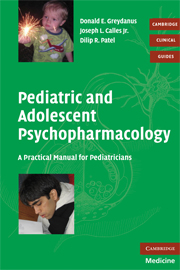Book contents
- Frontmatter
- Contents
- Contributors
- Foreword by Christopher K. Varley
- Foreword by Renée R. Jenkins
- Preface
- Acknowledgement
- 1 Principles of psychological management
- 2 The basics of pharmacology and neurotransmission
- 3 Basics of prescribing psychopharmacologic agents
- 4 Anxiety disorders
- 5 Attention deficit/hyperactivity disorder
- 6 Child and adolescent depression
- 7 Disruptive behavior and aggressive disorders
- 8 Schizophrenia in childhood and adolescence
- 9 Autism spectrum disorders
- 10 Psychotropic management of children and adolescents with cognitive–adaptive disabilities
- 11 Sleep disorders in children and adolescents
- 12 Tic disorders in children and adolescents
- 13 Substance abuse disorders
- Subject index
- References
4 - Anxiety disorders
Published online by Cambridge University Press: 18 December 2009
- Frontmatter
- Contents
- Contributors
- Foreword by Christopher K. Varley
- Foreword by Renée R. Jenkins
- Preface
- Acknowledgement
- 1 Principles of psychological management
- 2 The basics of pharmacology and neurotransmission
- 3 Basics of prescribing psychopharmacologic agents
- 4 Anxiety disorders
- 5 Attention deficit/hyperactivity disorder
- 6 Child and adolescent depression
- 7 Disruptive behavior and aggressive disorders
- 8 Schizophrenia in childhood and adolescence
- 9 Autism spectrum disorders
- 10 Psychotropic management of children and adolescents with cognitive–adaptive disabilities
- 11 Sleep disorders in children and adolescents
- 12 Tic disorders in children and adolescents
- 13 Substance abuse disorders
- Subject index
- References
Summary
Definition
Anxiety is characterized by an apprehensive anticipation or fear by the child or adolescent of some dangerous occurrence in the future. Anxiety is usually accompanied by unpleasant feelings, stress or tension and somatic symptoms and signs. Anxiety disorder is characterized by persistent fear or worry that causes significant distress and impairment of age-appropriate functioning such as school work, play, and interpersonal relations. The symptoms in anxiety disorder take up a significant amount of daily time of the child or the adolescent and such symptoms last over a period of several months, typically 6 or more months. Types of specific anxiety disorders as classified in the DSM–IV–TR are listed in Table 4.1.
Epidemiology
Anxiety disorders are highly prevalent in children and adolescents. The etiological theories implicate genetic factors, temperamental characteristics of the child, and environmental risk factors. The prevalence rate of anxiety disorders in children has been reported to be between 6% and 20%. The prevalence has been reported to be between 0.3% and 13% in the preadolescent age and between 0.6% and 7% in the adolescent age group. Some studies suggest that anxiety disorders may be more common in girls compared with boys. The age of onset varies depending on the specific disorder. Although the long-term course of childhood anxiety disorders is not clearly delineated, it is generally recognized that most tend to persist into adulthood. Adolescents with anxiety disorders are at a significantly higher risk for substance use, particularly alcohol use.
- Type
- Chapter
- Information
- Pediatric and Adolescent PsychopharmacologyA Practical Manual for Pediatricians, pp. 61 - 76Publisher: Cambridge University PressPrint publication year: 2008

